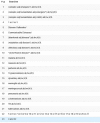Risk factors and risk factor cascades for communicable disease outbreaks in complex humanitarian emergencies: a qualitative systematic review
- PMID: 30002920
- PMCID: PMC6038842
- DOI: 10.1136/bmjgh-2017-000647
Risk factors and risk factor cascades for communicable disease outbreaks in complex humanitarian emergencies: a qualitative systematic review
Abstract
Background: Communicable diseases are a major concern during complex humanitarian emergencies (CHEs). Descriptions of risk factors for outbreaks are often non-specific and not easily generalisable to similar situations. This review attempts to capture relevant evidence and explore whether it is possible to better generalise the role of risk factors and risk factor cascades these factors may form.
Methods: A systematic search of the key databases and websites was conducted. Search terms included terms for CHEs (United Nations Office for the Coordination of Humanitarian Affairs definition) and terms for communicable diseases. Due to the types of evidence found, a thematic synthesis was conducted.
Results: 26 articles met inclusion criteria. Key risk factors include crowded conditions, forced displacement, poor quality shelter, poor water, sanitation and hygiene, lack of healthcare facilities and lack of adequate surveillance. Most identified risk factors do not relate to specific diseases, or are specific to a group of diseases such as diarrhoeal diseases and not to a particular disease within that group. Risk factors are often listed in general terms but are poorly evidenced, not contextualised and not considered with respect to interaction effects in individual publications. The high level of the inter-relatedness of risk factors became evident, demonstrating risk factor cascades that are triggered by individual risk factors or clusters of risk factors.
Conclusions: CHEs pose a significant threat to public health. More rigorous research on the risk of disease outbreaks in CHEs is needed, from a practitioner and from an academic point of view.
Keywords: other infection, disease, disorder, or injury; public health; systematic review.
Conflict of interest statement
Competing interests: None declared.
Figures
References
-
- Macias L. Complex Emergencies. Austin: Center for Climate Change and African Political Stability;. 2013.
-
- Paquet C, Hanquet G. Control of infectious diseases in refugee and displaced populations in developing countries. Bull Inst Pasteur 1998;96:3–14. 10.1016/S0020-2452(98)80024-9 - DOI
LinkOut - more resources
Full Text Sources
Other Literature Sources
Miscellaneous




